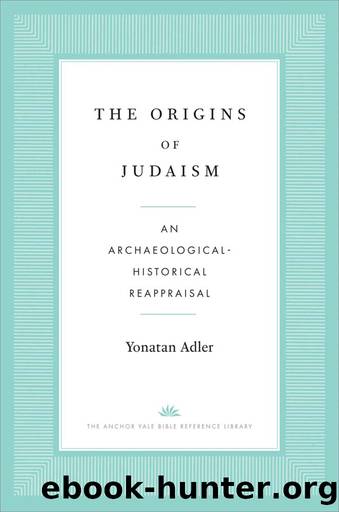The Origins of Judaism by Yonatan Adler;

Author:Yonatan Adler;
Language: eng
Format: epub
Publisher: Yale University Press
Published: 2022-01-15T00:00:00+00:00
7
The Origins of Judaism Reappraised
In each of the preceding chapters, we investigated practices and prohibitions legislated in the Torah which had come to be widely observed by the first century CE as integral components of a commonly followed Judaism. In chapter after chapter, we sought textual and material evidence that might indicate if these practices and prohibitions were being observed by regular Judeans in the centuries prior to the first century. In each and every case, we learned that the trail of the available evidence ends in the second century BCE at the earliest. In the preceding chapter, we learned that the second or first century BCE provides the earliest available evidence that regular Judeans were gathering in synagogues in order to read and interpret the Torah communally. The entirety of this evidence clearly establishes the second century BCE as the terminus ante quem for the initial widespread dissemination of the Torah among the Judean masses and its common acceptance as authoritative law. In simpler terms, Judaism as it is defined in this book must have emerged either sometime in the middle of the second century BCE or earlier.
The present chapter will be devoted to going beyond this data-driven terminus ante quem and will explore when it would have been most likely for the Torah to have been adopted as authoritative law among the Judean masses. We will begin by investigating the likelihood that this might have occurred as early as the Persian period, an idea that many scholars take for granted (as we saw in the section âThe History of Scholarshipâ in the introduction). As it will be shown that there are good reasons to think that at this time many Judeans knew nothing of the existence of anything resembling the Pentateuch, or at the very least were not adhering to its laws, we will proceed to assess the likelihood that Judaism may have emerged in the subsequent Early Hellenistic period. We will conclude this chapter with a cautious assessment of the proposition that the Torah came to be widely known to the masses and regarded as authoritative law only in the Late Hellenistic period, following the cataclysmic events surrounding the Hasmonean revolt toward the middle of the second century BCE.
The Persian Period (539â332 BCE)
Cyrus the Great (ca. 559â530 BCE), scion of the Teispid-Achaemenid royal dynasty of Persia, conquered Babylon in 539 BCE and consequently took hold of the vast territories that made up the Neo-Babylonian Empire of the time. Several communities of self-identifying Judeans are known to have flourished in various parts of this realm throughout much of the period of Persian rule, an era that ultimately ended with the conquests of Alexander the Great in the 330s BCE.
The present section seeks to assess the likelihood that the Torah might have come to be accepted by Judeans as their authoritative law and widely put into practice sometime during the Persian period. We will begin by examining the biblical narratives that are set in the days of the Teispid-Achaemenid
Download
This site does not store any files on its server. We only index and link to content provided by other sites. Please contact the content providers to delete copyright contents if any and email us, we'll remove relevant links or contents immediately.
| Haggadah | Hasidism |
| History | Holidays |
| Jewish Life | Kabbalah & Mysticism |
| Law | Movements |
| Prayerbooks | Sacred Writings |
| Sermons | Theology |
| Women & Judaism |
Man's Search for Meaning by Viktor E. Frankl(2276)
The Secret Power of Speaking God's Word by Joyce Meyer(2275)
Mckeown, Greg - Essentialism: The Disciplined Pursuit of Less by Mckeown Greg(2126)
MOSES THE EGYPTIAN by Jan Assmann(1992)
Unbound by Arlene Stein(1954)
Devil, The by Almond Philip C(1924)
The Complete Dead Sea Scrolls in English (7th Edition) (Penguin Classics) by Geza Vermes(1865)
I Capture the Castle by Dodie Smith(1594)
Schindler's Ark by Thomas Keneally(1529)
The Invisible Wall by Harry Bernstein(1472)
The Gnostic Gospel of St. Thomas by Tau Malachi(1426)
The Bible Doesn't Say That by Dr. Joel M. Hoffman(1382)
The Secret Doctrine of the Kabbalah by Leonora Leet(1280)
The Jewish State by Theodor Herzl(1264)
The Book of Separation by Tova Mirvis(1235)
A History of the Jews by Max I. Dimont(1223)
The Dead Sea Scrolls Bible by Martin G. Abegg(1217)
Political Theology by Carl Schmitt(1199)
Oy!: The Ultimate Book of Jewish Jokes by David Minkoff(1114)
